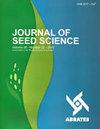缓生根瘤菌细胞的恢复及其对大豆种子生理品质的影响
IF 1.2
4区 农林科学
Q3 AGRONOMY
引用次数: 1
摘要
摘要:农民有时会播种大豆(Glycine max (L.))。在干燥的土壤中,预计短时间内会下雨。然而,预报可能无法证实,让接种的种子无限期地在干燥的土壤中。对接种后的大豆种子在干燥土壤上的生长性和生理品质进行了评价。第一次试验分别在播种后2 h、1、4、11、18、21 d灌水;第二个试验分别在灌溉前2 h、1、5、12、14、20 d播种。每个时间代表一个完全随机设计的治疗。在干燥土壤中播种后2 h,生长缓慢的根瘤菌细胞数量从接种后不久的每粒种子~8-9 × 104个菌落形成单位下降到-60%,并随着时间的推移下降到接近于零。虽然对发芽没有影响(第一次和第二次试验分别为59%和81%),但干燥土壤使出芽速度指数从第一次试验的19.5 (2 h)降至12.0 (21 d),第二次试验的37.8 (2 h)降至13.8 (21 d)。在第一次试验中,异常苗数从7% (2 h)增加到24% (21 d);第二阶段子叶出现裂纹,裂纹率从1% (2 h)增加到50%(≥5 d)。在干燥土壤中播种不仅会对接种的缓生根瘤菌产生负面影响,还会影响大豆种子的生理品质。本文章由计算机程序翻译,如有差异,请以英文原文为准。
Recovery of Bradyrhizobium cells and effects on the physiological quality of soybean seeds sown in dry soil
Abstract: Farmers sometimes sow soybean (Glycine max (L.) Merrill) in dry soil in the expectation of rain in the short time. However, the forecast may not confirm, letting the inoculated seeds in the dry soil indefinitely. We assessed the survival of inoculated Bradyrhizobium and physiological quality of soybean seeds sown in dry soil. In the first experiment, irrigation was applied with 2 h, 1, 4, 11, 18, or 21 days after sowing; in the second experiment, sowing was carried out 2 h, 1, 5, 12, 14, or 20 days before irrigation. Each time represented a treatment in a completely randomized design. Bradyrhizobium cells dropped from ~8-9 × 104 colony forming units per seed soon after inoculation to -60% at 2 h after sowing in dry soil, and decreased to close to zero with time in both experiments. Although there was no effect on germination (59% and 81% in the first and second experiments, respectively), the exposure to dry soil reduced the emergence speed index from 19.5 (2 h) to 12.0 (21 days) in the first experiment and from 37.8 (2 h) to 13.8 (21 days) in the second. In the first experiment, the number of abnormal seedlings increased from 7% (2 h) to 24% (21 days); in the second, cotyledons showed cracks, which increased from 1% (2 h) to ~50% (≥ 5 days). Sowing in dry soil negatively affects not only the inoculated Bradyrhizobium, but also the physiological quality of soybean seeds.
求助全文
通过发布文献求助,成功后即可免费获取论文全文。
去求助
来源期刊

Journal of Seed Science
Agricultural and Biological Sciences-Agronomy and Crop Science
CiteScore
2.00
自引率
30.00%
发文量
28
审稿时长
12 weeks
期刊介绍:
From 2017 the Journal of Seed Science (JSS) will circulate online version only.
Original scientific studies and communications, not yet published or submitted to another journal for publication and written in Portuguese or English, will be accepted for publication. For manuscripts submitted in English, the authors should provide an adequated version.
The SCIENTIFIC COMMUNICATION is a category of scientific manuscript which describes a technique, an equipment, new species or observations and surveys of limited results. It has the same scientific rigor as the “Scientific Articles” and the same value as a publication. The classification of a manuscript as a SCIENTIFIC COMMUNICATION is based on its content and scientific merit but it can be a preliminary study, simple and not definitive on a certain subject, with publication justified by its uniqueness and contribution to the area.
The Editorial Board of the JSS may invite leading authors of recognized reputation to compose specific Review Articles covering topics of their specialization that will convey to the scientific community the state-of-the-art knowledge related to the specific theme.
 求助内容:
求助内容: 应助结果提醒方式:
应助结果提醒方式:


